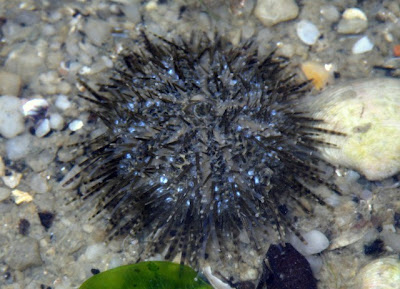On Monday, I was with a group of friends at Changi and I noticed some weird-looking sea cucumbers.
Like this white and purple sea cucumber.
While I was trying to think of what it was, I found yet another similar looking sea cucumber that is more purplish. It now seems to look like the purple sea cucumber (Family Cucumariidae).
Finally I found the third similar looking purple sea cucumber that has the most purplish pigments. Does the loss of purpe pigments indicate stress?

If that is so, this completely white sea cucumber that I have no idea also should also be very stressed. It feels smooth to the touch and it might probably be the smooth sea cucumber (Class Holothuroidea) that we usually we at Changi.
It is quite worrying to see distressed echinoderms on Changi which is quite heavily impacted by pollution, dredging, trampling and poaching.

We also saw this Orange sea cucumber (Family Cucumariidae) that we do not know of its species identification.

Another of the unidentified sea cucumber will be this Beige sea cucumber (Class Holothuroidea).
There is yet so much that we don't know about our very own marine biodiversity! And that's not all.

I saw several of these small ball looking creatures which I believe are also sea cucumbers. They come in yellow and orange.

A closer at this unknown creature. I've never seen them before but yesterday they were gathering at the seagrass area.
Alas, there were still sea cucumbers that we have some idea what they were. :-)

Like this ball sea cucumber (Phyllophorus sp.). A traditional Malay tonic called ‘Air Gamat’ is made from their body fluids which are collected and left to stand for several weeks. The tonic is a popular local remedy for faster healing of wounds and as a post-natal treatment.
And it is possible that there are many natural uses from these creatures. But if we destroy their habitats and these creatures, we will never be able to discover these uses.

I always love to see these red pretty Thorny sea cucumber (Colochirus quadrangularis) on our shores. Especially with their feeding tentacles out.
That's quite a lot of different types of sea cucumber that were found in just one trip.
Changi is well known to be rich in echinoderms and we found many of the other types of echinoderms.

Like this Black sea urchin (probably Temnopleurus toreumaticus).

The underside of this tiny sea urchin.

On the seagrass areas, there were several charismatic sea stars like this Biscuit sea star (Goniodiscaster scaber).

It was nice to find the Spiny sea star (Gymnanthenea laevis) again at Changi.

What was unique of this spiny sea star is that it has a very tiny yet pretty brittlestar on its surface. Can you see it. The brittlestar has white and yellow bands!
Indeed the trip could be a happy one with the echinoderm sightings except for the "bleaching" cucumbers.











5 comments:
Wow I am amazed at all these sea creatures. Thanks for sharing.
You have taken some amazing pictures, please keep it up, I'll going to follow your page.
Glad to hear your kind comments Alice and Wiser. Yeah, we should go find out what beautiful marine life we have before they are gone since coastal development is not uncommon in Singapore. May more people be able to appreciate these creatures.
These pictures are beautiful! Those yellow and orange ball shaped things you mentioned in your photos were sea cucumbers. They are called ball sea cumbers. I think.
Hi, glad you like the pictures. Actually on a second thought, those "ball sea cucumbers" are probably sponges. :-)
http://www.wildsingapore.com/wildfacts/porifera/ballprickly.htm
Post a Comment